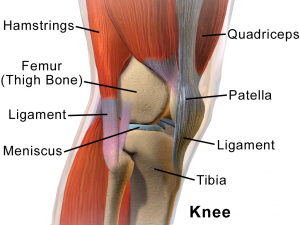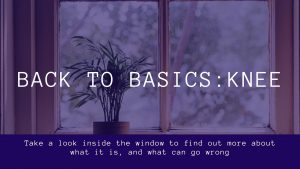If you have an injury to your knee you know how vital this joint is to moving around everyday. Here we try to simplify what it is and what can go wrong along with debunking some common myths that we hear in the clinic.
What is it?
The knee joint joins the femur (thigh bone) to the tibia (shin bone). A smaller bone which runs alongside the tibia (fibula) and the patella (kneecap) also contribute to the knee joint. The knee joint moves in one plane of movement (flexion and extension or bending and straightening).
Tendons connect the muscles surrounding the knee to the bone and ligaments provide support to the joint. The collateral ligaments (either side of the knee joint) prevent sideways movement of the knee) while the cruciate ligaments prevent anterior and posterior translation (forwards and backwards movement) of the tibia on the femur.
Two C-shaped pieces of cartilage called the medial and lateral meniscus act as shock absorbers for the knee joint.
What can go wrong?
Common injuries/conditions of the knee include:
- Knee osteoarthritis
- ACL injuries
- Meniscal tears
- Patellofemoral pain
- Patellar tendinopathy
- Osgood-Schlatter Syndrome
If you are experiencing knee pain, don’t hesitate to contact the clinic to book an assessment.
 Image Source:
Image Source:
Blausen.com staff (2014). “Medical gallery of Blausen Medical 2014“. WikiJournal of Medicine 1 (2). DOI:10.15347/wjm/2014.010. ISSN2002-4436.
Common Myths Debunked
# 1. I have knee pain so I should decrease my physical activity levels, because it will increase pressure on my joints and make my pain worse.
The fact is that an active lifestyle is important for everyone – including those experiencing knee pain. People who suffer from knee pain are at risk of not getting enough movement in their daily lives, but this can actually cause more joint problems later. Unless you have an acute knee injury and it has been advised that you temporarily reduce your physical activity, you should be aiming to move for at least 30-60 minutes each day. One study which looked at physical activity in older adults with knee pain showed that there was no evidence of increases in pain, decreases in physical function, or progression of structural osteoarthritis on imaging with regular physical activity.
#2. When knee pain is caused by osteoarthritis, total knee replacement is the only option.
The fact is that knee surgery is recommended in very few people with knee arthritis and only if an appropriate course of other non-surgical strategies has been unsuccessful. Exercise and weight loss (if appropriate) is a first line treatment and should be undertaken by all people with knee osteoarthritis. There is evidence to suggest that land-based therapeutic exercise provides benefits in terms of reduced knee pain and improved quality of life and physical function in people with knee osteoarthritis.
#3. My x-ray shows that my arthritis is bone on bone.
X-rays show us narrowing of the joint space between the thigh and shin bone. They are useful in some circumstances but they don’t give us an accurate image of what is happening in the knee when you are moving or when you are experiencing pain. X-rays can be misleading as what you see on x-ray won’t always fit with the pain you are experiencing. It is not uncommon for people to have pain without any changes on their x-ray, or for them to have significant changes to the knee but not experience any pain. It is also important to remember that there is strong evidence that physical activity doesn’t cause progression of osteoarthritis on imaging.


